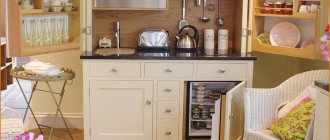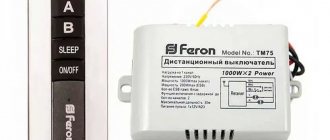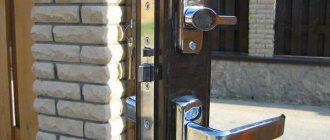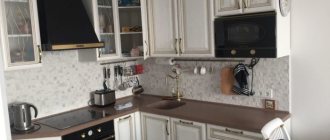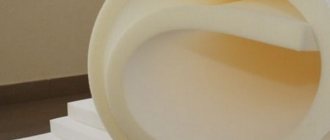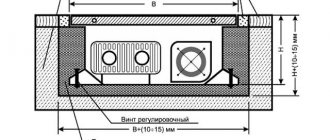A person’s cheerfulness, well-being and mood primarily depend on the quality of the air he breathes. Of course, not everyone is lucky enough to breathe clean sea or high mountain air every day. Most people live in large, dusty and smoky cities, where cars and factories poison the air every day.
In order for the air in your apartment to be cleaner than outside, it must be purified daily. Built-in kitchen hoods can handle this difficult task quite easily.
Why is there a hood in the kitchen?
In addition to its main function, preventing smoke and gas from entering other rooms in your apartment, built-in hoods can also perform other tasks. They can purify the air in the kitchen not only from steam and smoke that comes from the stove, but also improve the quality of the air that comes from the street. Smells that are constantly present in any kitchen can negatively affect a person.
Hoods are able to combat polluted air, clean it of odors, gases and decay products
For example, no one likes the smell of boiled cabbage and raw fish, let alone dishes that are slightly burnt. Such smells can cause not only discomfort in a person, but also negative emotions and even repel hunger. Do not forget that odors are very well absorbed into upholstered furniture, interior items, and clothing. They can be very persistent, and in order to get rid of them you will have to work hard. Built-in kitchen hoods will help you solve all these problems with ease.
Performance
Appearance is not all that is important to think about when choosing a hood for the kitchen. One of the most important features to look for is performance and power. Here we will talk about how many cubic meters. m of air can be cleaned by a hood in one hour of operation.
The larger the kitchen area, the correspondingly greater performance the hood should have. However, the concentration of harmful substances in the air of small kitchens can be several times higher than in spacious ones. Therefore, it is extremely important that the air contaminated with evaporation is processed quickly, which only high-power hoods can cope with.
It is advisable to calculate the required extraction capacity
Types of built-in hoods
From the name of this type of hoods one can draw one very precise conclusion: they must be built in somewhere. Most often, built-in hoods are mounted in a wall cabinet, but there are hoods that are built directly into the wall. Also, special attention should be paid to hoods that are built into the countertop. What is the difference between all these types, and which hood is ideal for your kitchen?
- Fully built-in horizontal hoods are installed in kitchen cabinets. In order for them to be as efficient as possible in your kitchen, it is recommended to install a cabinet with built-in hoods directly above the stove or hob. Fully built-in hoods have a huge advantage over dome and island hoods. After all, the hood itself is completely hidden from view, but there are often options when the retractable surface extends slightly and peeks out from under the cabinet.
- The newest type is a hood built into the countertop. Kitchen hoods of this type have a completely new ventilation system that is different from other types. In America, the new technology is called “downdraft ventilation.” This type of hood is built directly into the countertop next to the stove, steamer, or other cooking surface. When the hood is turned off, special flaps close it. When the hood is turned on, the doors automatically open and begin to draw in all the steam and smoke even before it has time to rise high. It should be noted that built-in hoods can be either stationary or retractable. A retractable hood, in turn, can be completely hidden in the countertop and become completely invisible. Thanks to their unusual location, countertop hoods are increasingly becoming an excellent alternative to island hoods. If you don’t believe me, you can read positive reviews from satisfied customers.
- Flat hoods can also be classified as built-in. Although, they are not built inside the cabinet, but are simply attached under it. Thanks to this fact, installing such a hood is quite simple. They also work very simply, the air that the hood draws in passes through all the filters, is cleaned and again enters the kitchen. Naturally, filters become dirty over time, so they need to be changed regularly. However, after replacing the filters, the hood will work like new again.
- Telescopic hoods can also be considered built-in. They are also called “sliders”. In turn, telescopic hoods are completely hidden from prying eyes during non-working hours. A special screen extends out of the cabinet only when the hood is operating. It is able to draw out a fairly large amount of air and quickly process it. Telescopic hoods are a little more expensive than flat or conventional built-in hoods. Also, it should be noted that telescopic hoods can have a variety of sizes, so they can be built into any kitchen cabinets.
It should be noted that the above types of hoods do not reduce the space in the kitchen at all. This is one of the advantages of built-in hoods. In order for the hood to work as efficiently as possible, it is necessary to take into account its dimensions.
It is necessary that the dimensions of the hood match the dimensions of the stove, but it will be even better if the hood is a couple of centimeters larger.
This way it can cover a larger surface and prevent smoke and steam from spreading throughout the kitchen. Numerous positive reviews prove that built-in hoods are very popular and convenient to use today in both small and large kitchens.
Installation
When choosing a hood for the kitchen, it is important to pay attention to how it is installed.
By type of installation, devices are:
- Wall-mounted. Installed either against the wall above the stove, or separately or inside furniture to free up space;
- Island. Requires more complex installation, because usually located in the center of the room and attached to the ceiling, connecting to the air duct. An island hood can easily be called an independent design element;
- Angular. They are mounted in the corner of the kitchen, thereby allowing designers to implement interesting ideas. But today the range of such models is small.
Please note that the distance between the hood and the stove must be at least 60 cm.
What to look for when choosing
The kitchen of a modern person simply cannot be equipped with a range hood. Most people try to choose built-in hoods, because they have excellent characteristics and do not at all spoil the design installed in the kitchen. However, I don’t know everything about how to choose the right hood for the kitchen, and what you should pay attention to when choosing it.
It’s hard to imagine a modern kitchen without a hood
First of all, you need to correctly calculate what productivity the device you need should have. Kitchen hoods built into a cabinet can have very different performance, but the power of its operation in your kitchen directly depends on this.
You can calculate the performance you need using a simple formula: H x S x 12 x 1.3. In this case, H is the distance from the ceiling to the floor, S is the total area of the kitchen, which is measured in square meters. The number 12 indicates the SES norm, and 1.3 is the standard coefficient. The value you get will be measured as cubic meters/hour. You can deviate from this value, but it is best to do this upward, because otherwise the hood will not be powerful enough for your kitchen. Even if it always operates at full capacity, which will significantly reduce its service life, it will not cope well with its main task - air purification.
Work device
And before determining which hood will be better for the kitchen, it is worth understanding the principle of their operation. You need to know this, if only because the cost and service life depend on it. The operation of a kitchen hood is as follows:
- The steam is directed directly to the hood due to the fans installed in it.
- The filter installed in it retains all the incoming dirt and soot that is released during cooking.
- The air duct takes unpleasant odors either outside or back into the room, passing them through a filter.
There is nothing complicated about this, because several subtleties take on all the “heaviness”. And if they are not taken into account, then it may well happen that buying the best built-in hood will be useless.
Filters for built-in hoods
It is not difficult to guess that for any hood it is the filter that plays the most important role. It is the filter that determines how efficiently and quickly the air in your kitchen will be purified. Filters come in coarse and fine filter types. Coarse filters are called grease filters; they save kitchen cabinets, cabinets and wallpaper from grease settling on them. Fine filters, carbon, purify the air from steam, gas and decay products.
In conventional flow hoods there is only a coarse filter. In this case, it serves as excellent protection not only for the kitchen, but also for the hood itself, which is undoubtedly damaged by fatty deposits. In turn, both filters are built into circulating kitchen hoods.
Now a little about the filters themselves. It should be noted that coarse filters can consist of reusable and disposable elements. The shelf life of the filter depends on the nature of these elements. Thus, disposable filters will serve you for no more than one cycle, after which they will have to be replaced with new ones. As for reusable filters for built-in hoods, they can be washed even under running water. It is, of course, advisable to use special detergents when cleaning them. This way they can last much longer. At this stage of life, there are three main types of filters:
- Sintepon, they are also paper. These filters cannot be used more than once.
- Reusable aluminum. This type of filter consists of specially treated aluminum, which is arranged in several layers. In order for the aluminum filter to serve you for a long time, it needs to be cleaned at least once every two weeks.
- An acrylic filter is also a reusable filter. He does not require special attention. You can wash it once a month.
It is very important to wash and clean reusable filters on time. If you don't take care of them, they begin to be forgotten by small particles of food and fat, which is why the hood allows less air to pass through.
This also greatly affects the engine load. It begins to work harder at cleaning, which causes it to wear out faster. To ensure that you never have such problems, and you always know that it is time to clean or replace the filter, many hoods have a special replacement indicator. Expensive built-in hoods themselves can determine when it is time to change the filters.
Fine filters clean the air from odors, as well as burning and dust using activated carbon. That is why fine filters are called carbon filters. We are all accustomed to the fact that these filters are strictly disposable. However, reusable carbon filters have recently begun to appear on consumer markets. They were able to quickly receive positive feedback from customers, since using them is really very easy and simple. Reusable carbon filters do not use simple activated carbon, but compressed carbon. This design can be easily washed under running water, dried in the sun, or in the oven, and then used again.
Popular manufacturing brands
When choosing a range hood model for your kitchen, it is better to give preference to products from well-known brands that are famous for their high quality equipment.
Hoods produced under the Bosch, Siemens and Krona brands are very popular. These brands offer flagship device models at mid-range prices.
You can also note such brands as Gorenje and Hansa. There are many positive reviews about them from customers.
Among Russian-made hoods, the popular brand is Elikor, famous for its excellent build quality and stable operation.
Noise level of built-in hoods
While the hood is not working, there is comparative silence in your kitchen, however, as soon as you turn it on, you will no longer hear your own thoughts. Does it really have to be this way? How silent can a built-in hood be? Well, indeed, during operation, hoods make quite a lot of noise. However, this noise can be completely different in volume. It entirely depends not only on the model of the built-in hood you have chosen, but also on the correctness of its installation.
By the way, the power of the device also greatly affects the noise level. The more powerful the hood, the more noise it creates. There is a popular belief among people: “The more expensive the hood, the less noise it makes!” Unfortunately, we will have to disappoint you, because the noise of a hood depends not on its cost, but on its quality. High-quality hoods can produce noise of no more than 35 dB. This noise level can be compared to a boiling pan on gas.
A typical, average built-in hood produces up to 50 dB of noise. This is a level of quiet conversation that is not too distracting and allows you to concentrate on your own affairs. Hoods with noise above 55 dB may well cause discomfort among household members, especially if they operate quite often. The developers approached the problem of noise very intelligently. The motors of some hoods use special silent bearings.
Sometimes, one powerful fan is replaced by two, which operate at medium speeds, but cope with polluted air at a high level. Such hoods also have positive reviews among buyers. The best and most effective way to completely get rid of noise is to move the fan outside the kitchen, to the street. True, not everyone has such an opportunity. This procedure is only possible in a private house, since the apartment has only one hole for central ventilation.
Rating
And a conversation about the best option for the kitchen would not be complete without a rating that contains the best built-in and hanging hoods. Let's look at their key advantages, as well as their advantages and disadvantages.
Gorenje DU5345W
First place in the ranking among budget models. This wall-hung model is an excellent option for a small kitchen with its performance as well as double filtration. In addition, there is a backlight and three modes of operation of the blades. The disadvantage is the high noise level.
Pros:
- low price;
- easy installation.
Minuses:
- loud sound: exceeds 50 dB.
The controls are completely mechanical.
Elikor 60
A fairly confident model in the budget segment, and can rightfully be considered an improved version of Gorenje. It features operation without connection to ventilation - circulation mode - and with connection, if necessary. However, this is reflected in its cost, because there is no carbon filter or backlight.
Advantages:
- price;
- low noise;
- versatility in installation.
Flaws:
- lack of a carbon filter;
- overall weak functionality compared to competitors.
There is a mechanical control and a grease filter.
Candy CBT 6130 X
The middle class in the ranking is opened by Candy, which offers a built-in solution for small kitchens. Moreover, it has two engines and operates in two modes. The filtration system is a two-stage system, and there are also three rotation speeds. The kit includes a carbon and grease filter.
Strengths:
- silence: low noise level;
- average functionality, suitable for most;
Weak sides:
- poor performance, which is inferior to budget models;
- short connection cable.
Push-button control is compensated by the presence of backlighting.
Zigmund Shtain K 003
The most powerful hood in the rating is 1000 m3/h. At the same time, it has a fairly small size and the ability to work both in air recirculation and in its exhaust. There are three speeds and lighting using incandescent lamps.
Pros:
- high performance;
- presence of an anti-return valve;
- Quite low noise, despite the power - up to 56 dB.
Minuses:
- one filtration stage.
Grease filter included, push-button control.
Hansa OKC 6726
A premium solution in this rating, made in the form of a dome. Features include two main operating modes, three speeds and the presence of a term. The cost and premium quality is due to modern design and high-quality components.
Pros:
- modern design;
- quiet work.
Minuses:
- Lack of carbon filter included.
Electronic control.
When choosing a small or, conversely, large and powerful solution, you need to remember one thing: the main thing is not the product, but why you are buying it. If it fits perfectly into your interior and meets your requirements, then it doesn’t matter where it is in the rating and how good its technical characteristics are. There is no need to spend little because you always get what you pay for. It is more rational to spend in moderation, but for a long service life.
Functions and controls
It is the number of different functions that your built-in cabinet hood is equipped with that will determine its complexity to operate. Simple hoods have only a few functions, so operating them is quite simple and convenient. Most often this involves turning the lights on and off, as well as switching between several fan modes. Most often, switches are made of push-buttons, less often - touch-sensitive. Of course, we can immediately conclude that a built-in hood with touch control will be more expensive. This is of course true, but in this case the price comes into play.
Caring for a hood with touch control is much easier. Grease will never accumulate on the control panel or between the buttons. Models that are much higher in class very often do not even have touch control, but electronic remote control. This control system allows you to install programs that are convenient for use. You can adjust the fan speed over time.
Set the residual stroke, and many other necessary functions. Quite expensive hoods have in their arsenal such a function as connecting to the Smart Home system. Which, in turn, does not require any human intervention in the operation of the equipment. Also, do not forget that many hoods are equipped with a special timer, thanks to which you can configure several operating options. By purchasing a built-in hood, you can make your life more comfortable, and your work in the kitchen much more enjoyable and useful. You will no longer have to breathe air contaminated with gases and vapors. Now that you have a hood, your kitchen will become a magnificent oasis for all household members, and working in it will begin to bring you joy and pleasure. Built-in hoods can not only purify the air, they will also help you create a unique home comfort.
Which company should you choose?
If you want your hood to fully serve you for many years, we recommend that you choose a model from the range of the most reliable and high-quality manufacturers:
- Weissgauff is a German company with a wide range and affordable price tag;
- Krona is another brand from Germany that has long gained popularity for its wide selection of household appliances for every taste and budget;
- ELIKOR is one of the largest domestic manufacturers of kitchen hoods;
- Hansa - Amica group of companies, uniting the European production of household appliances, including the premium segment;
- smeg is an Italian company producing household appliances with a large number of its own developments and unique designs.


